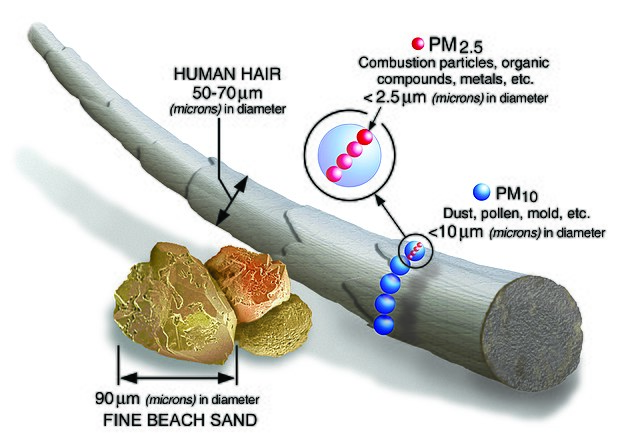
Why is PM 2.5 dangerous? They are particles that are too small for our nose to catch.
PM stands for Particle Matter and they are microscopic solid or liquid particles that are small enough and light enough to be suspended in the air. There are many sources of these particles. In some countries, one of the largest sources can be wood smoke. There are many different sizes of particle, but PM 2.5 means particles that are 2.5 microns across (0.0025mm).
So, why is PM 2.5 dangerous? It is because the particles are too small for our nose to catch. Our noses are our first line of defense against airborne particles. The nose has a number of jobs. It warms and humidifies the air that we breathe. Cold, dry air can be harmful to the lungs, so the nose brings it up to a suitable temperature and moistens it. When we breathe in, the air goes into our nasal cavity. There are folds of tissue called turbinates that have many tiny blood vessels in them. The folds increase the surface area and the blood vessels supply heat energy to the air coming in. There are also a large number of hairs and a copious amount of sticky mucus inside the nose and nasal cavity. We produce about 4 cups of mucus a day and we swallow the majority of it without being aware. Dust, bacteria, and particles get stuck in this mucus and we swallow them so that they can be dissolved in the stomach. The hairs are actually to move the mucus toward the back of the throat so we can swallow what is trapped there.
The nose is very good at catching most things that are 10 microns or more across. It is not so good at catching things that are smaller and PM 2.5 is obviously smaller than that. The particles go straight past the nose and down into the lungs. They can lodge anywhere down the respiratory tract, and even get stuck in the alveoli of the lungs. Wherever they lodge, they can cause cancers to form. If the particles are even smaller than that, they can pass through the lining of the lungs and into the blood. There, they can lead to buildups of plaque and a hardening of the arteries. It is thought that PM 2.5 is responsible for over 4.2 million deaths around the world every year.
Where do PM 2.5 come from? There are many sources of PM 2.5 As I said previously, wood smoke is a big producer, especially in the winter when a lot of houses are heated by wood burning stoves. Recently, climate change has increased the number of forest fires that occur every year, which throws even more PM 2.5 into the air. Dust kicked off the road by vehicles is another large source. Construction sites as well. When stone is crushed or broken, the stone dust can become airborne particles. One of the largest sources of PM 2.5 is the combustion of gasoline, oil, or diesel. This obviously means that vehicles on the road are one of the biggest problems.
Because PM 2.5 is dangerous, the WHO has set guidelines for how much we should be exposed to. PM 2.5 is measured in micrograms (μg) per m3 and the WHO says that we shouldn’t be exposed to more than 5 μg/m3 as a yearly average and no more than 15 μg/m3 in a 24-hour period for more than 4 days in a year.
Last year, a study of PM 2.5 levels was done in 6,475 cities around the world. Out of all of those cities, only 222 were within the standards set by the WHO. Many of them were far above the limits set. These levels are obviously worrying, but it is possible to solve the PM 2.5 problem. Electric vehicles, filters on all factories, and electric heating would have a huge impact. The problem is that most of the places most affected by PM 2.5 are poorer countries where they don’t have the luxury of being able to solve the problem. Hopefully, as these technologies advance, they will become cheaper and more available around the world. In the meantime, a surgical mask that will stop a virus does a very good of cutting out PM 2.5.
So, why is PM 2.5 dangerous? Because the particles are too small for your nose to stop, and they can go down into the lungs. When they get trapped in the lungs, they can cause cancers and some smaller particles can pass through into the blood and cause cardiovascular diseases. And this is what I learned today.
https://en.wikipedia.org/wiki/Particulates
https://www.health.ny.gov/environmental/indoors/air/pmq_a.htm
https://www.epa.gov/pm-pollution/particulate-matter-pm-basics
https://allergyasthmanetwork.org/news/your-nose-the-ultimate-air-cleaner
https://smartairfilters.com/en/blog/surgical-masks-surprisingly-effective-pm2-5
https://www.c40knowledgehub.org/s/article/WHO-Air-Quality-Guidelines?language=en_US
